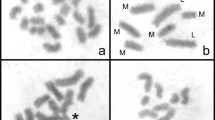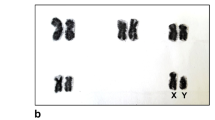Abstract
Male karyotype and meiosis of Tenagobia fuscata(Corixoidea, Micronectidae) are studied. The species possesses a male diploid chromosome number 2n= 28 + XY, holokinetic chromosomes, absence of m chromosomes and an achiasmatic male meiosis. Autosomes divide pre-reductionally while the sex chromosomes do so post-reductionally. Banding techniques (C, DAPI and CMA) show that large heterochromatic AT-GC rich bands are generally terminally located, although some interstitial bands are also detected. Many bivalents are heteromorphic for heterochromatin amount and location. This is the first report of a species with achiasmatic male meiosis within the Nepomorpha. These cytogenetic features markedly differ from all previous reports for 26 species of the superfamily Corixoidea. T. fuscata occurs in permanent shallow water bodies, and most known individuals are brachypterous. Their dispersion depends on occasional floodings of the water bodies they occupy. Since achiasmatic meiosis maintains groups of co-adapted genes, this feature could be an adaptive strategy of the species to the particular type of habitat and ecological niche it occupies.
Similar content being viewed by others
References
Bachmann, A.O., 1981. Insecta, Hemiptera, Corixidae. Edited by R.A. Ringuelet, FECIC, La Plata.
Camacho, J.P.M., J. Belda & J. Cabrero, 1985. Meiotic behaviour of the holocentric chromosomes of Nezara viridula (Insecta, Heteroptera)analysed by C-banding and silver impregnation. Can. J. Genet. Cytol. 27: 490–497.
Geitler, L., 1939. Das Heterochromatin der Geschlechtschromosomen bei Heteropteren. Chromosoma 1: 197–229.
GonzÁlez-García, J.M., C. Antonio, J.A. Suja, & J.S. Rufas, 1996. Meiosis in holocentric chromosomes: kinetic activity is randomly restricted to the chromatid ends of sex univalents in Graphosoma italicum (Heteroptera). Chromosome Res. 4: 124–132.
Grozeva, S. & S. Nokkala, 2001. Chromosome numbers, sex determining systems, and patterns of the C-heterochromatin distribution in 13 species of lace bugs (Heteroptera, Tingidae). Folia biol.(Krakòw) 49: 29–41.
Hales, D.F., 1989. The chromosomes of Schoutedenia lutea (Homoptera, Aphidoidea, Greenideinae). Chromosoma 98: 295–300.
Halkka, O., 1956. Studies on the mitotic and meiotic cell division in certain Hemiptera under normal and experimental conditions. Ann. Acad. Sci. Fenni. 32: 5–80.
John, B., 1990. Meiosis. Edited by Cambridge University Press, Cambridge.
King, M., 1993. Species Evolution: The Role of Chromosome Change. Edited by Cambridge University Press, Cambridge.
Montgomery, T.H., 1901. Further studies on the chromosomes of the Hemiptera Heteroptera. Proc. Acad. Nat. Sci. Philadelphia 20: 154–236.
Nokkala, S. & S. Grozeva, 2000. Achiasmatic male meiosis in Myrmedobia coleoptrata (Fn.) (Heteroptera, Microphysidae). Caryologia 53: 5–8.
Panzera, F., R. Perez, Y. Panzera, F. Alvarez, E. Scvortzo. & R. Salvatella, 1995. Karyotype evolution in holocentric chromosomes of three related species of triatomines (Hemiptera-Reduviidae). Chromosome Res. 3: 143–150.
Papeschi, A.G., 1988. C-banding and DNA content in three species of Belostoma (Heteroptera) with large differences in chromosome size and number. Genetica 76: 43–51.
Papeschi, A.G., 1991. DNA content and heterochromatin variation in species of Belostoma (Heteroptera, Belostomatidae). Hereditas 115: 109–114.
Papeschi, A.G. & M.J. Bressa, 2002. Cytogenetic studies in Belostomatidae from Argentina. Abstracts of the Second Quadrennial Meeting of the Int.Heteropterists Soc. 46.
Papeschi, A.G., L.M. Mola, P. Rebagliati, S. Rodriguez Gil & M.J. Bressa, 2001. Heterochromatin characterization in the holokinetic chromosomes of some Heteroptera, Odonata and Araneae with DAPI–CMA. Abstracts 14th Chromosome Conference, Chromosome Res. 9: 75.
Peters, W. & M. Kleba, 1971. Meiotic chromosomes of Krizousacorixa femorata (Heteroptera: Corixidae). Ann. Entomol. Soc. Am. 64: 965–968.
Poisson, R., 1936. Nouvelles observations sur le processus spermatogénétique dans les éléments sexuels d'Hemiptères aquatiques. Arch. Zool. Exp. Gen. 78: 133–194.
Prokofieva, A.A., 1933. Vergleichend-karyologische Untersuchungen an elf Arten der Familie Corixidae (HemipteraHeteroptera). Z. Zellf. 19: 1–27.
Rebagliati, P., A.G. Papeschi & L.M. Mola, 2003. Meiosis and fluorescent banding in Edessa meditabunda and E. rufomarginata (Heteroptera: Pentatomidae: Edessinae). Eur. J. Entomol. 100: 11–18.
Sahara, K., F. Marec & W. Traut, 1999. TTAGG telomeric repeats in chromosomes of some insects and other arthropods. Chromosome Res. 7: 449–460.
Schaefer, C.W. & A.R. Panizzi, 2000. Heteroptera of Economic Importance.Edited by CRC Press, Florida, USA.
Schuh, R. & J. Slater, 1995. True Bugs of the World (Hemiptera: Heteroptera): Classi cation and Natural History. Edited by Cornell University Press, New York, USA.
Slack, H.D., 1938. The association of non-homologous chromosomes in Corixidae (Hemiptera-Heteroptera). Proc. Roy. Soc. Edimb. 58: 192–212.
Solari, A.J. & S. Agopian, 1987. Recombination nodules, synaptonemal complexes and heterochromatin in the hemipteran Triatoma infestans. Mic. Electrónica y Biol. Cel. 11: 179–195.
Southwood, T.R.E. & D. Leston, 1959. Land and Water Bugs of the British Isles. Edited by Frederick Warne and Co., London.
Takenouchi, Y. & N. Muramoto, 1968. A survey of the chromosome in twenty-three species of heteropteran insects. J. Hokkaido Univ. Educ. IIB 19: 1–19.
Ueshima, N., 1979. Hemiptera II: Heteroptera. Edited by B. John, Gebrüder Borntraeger, Berlin-Stuttgart.
White, M.J.D., 1973. Animal Cytology and Evolution. Edited by Cambridge University Press, London.
Author information
Authors and Affiliations
Rights and permissions
About this article
Cite this article
Ituarte, S., Papeschi, A. Achiasmatic Male Meiosis in Tenagobia (Fuscagobia) fuscata (Stål) (Heteroptera, Corixoidea, Micronectidae). Genetica 122, 199–206 (2004). https://doi.org/10.1023/B:GENE.0000041048.75715.68
Issue Date:
DOI: https://doi.org/10.1023/B:GENE.0000041048.75715.68




